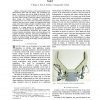Free Online Productivity Tools
i2Speak
i2Symbol
i2OCR
iTex2Img
iWeb2Print
iWeb2Shot
i2Type
iPdf2Split
iPdf2Merge
i2Bopomofo
i2Arabic
i2Style
i2Image
i2PDF
iLatex2Rtf
Sci2ools
ICRA
2007
IEEE
2007
IEEE
Mechanical design of a new pneumatically driven underactuated hand
—This paper presents a new pneumatically driven underactuated hand with two fingers and 3 phalanxes per finger. Two evidences have led the design of this hand. Firstly, the use of pneumatic energy facilitates the underactuation of the hand, indeed a single T-connector suffices to share out one input among two outputs. Secondly, non-backdrivable mechanisms have to be used in the transmission of phalanx’s motion so that the hand is capable of producing form-closed grasps. This latter design principle is justified using a newly developed method that permits to study the form-closure property of a grasp exerted by an underactuated hand. Moreover, the intriguing ejection phenomenon is avoided thanks to non-backdrivable mechanisms that prohibit any backward motion of phalanxes when correctly positioned. An original mechanism called the “pneumatic parallelogram” is described, it enables the hand to perform fine pinch grasps. Finally, the optimal design of both fingers is addressed wit...
| Added | 03 Jun 2010 |
| Updated | 03 Jun 2010 |
| Type | Conference |
| Year | 2007 |
| Where | ICRA |
| Authors | Vincent Begoc, Sébastien Krut, Etienne Dombre, Claude Durand, François Pierrot |
Comments (0)

